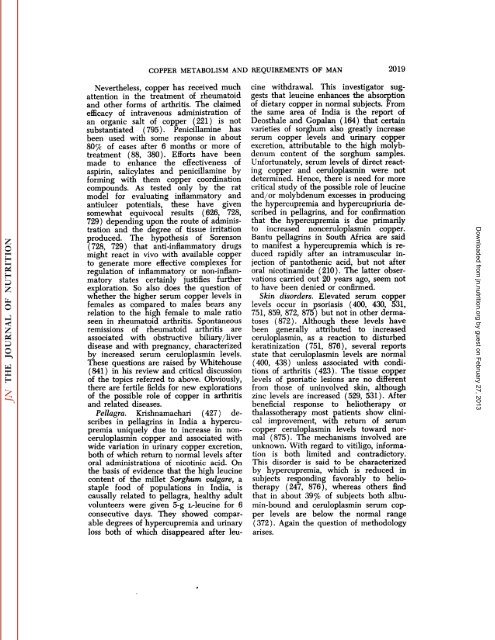conspectus of researchon copper metabolism and requirements
conspectus of researchon copper metabolism and requirements
conspectus of researchon copper metabolism and requirements
Create successful ePaper yourself
Turn your PDF publications into a flip-book with our unique Google optimized e-Paper software.
COPPER METABOLISM AND REQUIREMENTS OF MAN 2019<br />
Nevertheless, <strong>copper</strong> has received much<br />
attention in the treatment <strong>of</strong> rheumatoid<br />
<strong>and</strong> other forms <strong>of</strong> arthritis. The claimed<br />
efficacy <strong>of</strong> intravenous administration <strong>of</strong><br />
an organic salt <strong>of</strong> <strong>copper</strong> (221) is not<br />
substantiated (795). Penicillamine has<br />
been used with some response in about<br />
80% <strong>of</strong> cases after 6 months or more <strong>of</strong><br />
treatment (88, 380). Efforts have been<br />
made to enhance the effectiveness <strong>of</strong><br />
aspirin, salicylates <strong>and</strong> penicillamine by<br />
forming with them <strong>copper</strong> coordination<br />
compounds. As tested only by the rat<br />
model for evaluating inflammatory <strong>and</strong><br />
antiulcer potentials, these have given<br />
somewhat equivocal results (626, 728,<br />
729 ) depending upon the route <strong>of</strong> adminis<br />
tration <strong>and</strong> the degree <strong>of</strong> tissue irritation<br />
produced. The hypothesis <strong>of</strong> Sorenson<br />
(728, 729) that anti-inflammatory drugs<br />
might react in vivo with available <strong>copper</strong><br />
to generate more effective complexes for<br />
regulation <strong>of</strong> inflammatory or non-inflam<br />
matory states certainly justifies further<br />
exploration. So also does the question <strong>of</strong><br />
whether the higher serum <strong>copper</strong> levels in<br />
females as compared to males bears any<br />
relation to the high female to male ratio<br />
seen in rheumatoid arthritis. Spontaneous<br />
remissions <strong>of</strong> rheumatoid arthritis are<br />
associated with obstructive biliary/liver<br />
disease <strong>and</strong> with pregnancy, characterized<br />
by increased serum ceruloplasmin levels.<br />
These questions are raised by Whitehouse<br />
(841) in his review <strong>and</strong> critical discussion<br />
<strong>of</strong> the topics referred to above. Obviously,<br />
there are fertile fields for new explorations<br />
<strong>of</strong> the possible role <strong>of</strong> <strong>copper</strong> in arthritis<br />
<strong>and</strong> related diseases.<br />
Pellagra. Krishnamachari (427) de<br />
scribes in pellagrins in India a hypercupremia<br />
uniquely due to increase in nonceruloplasmin<br />
<strong>copper</strong> <strong>and</strong> associated with<br />
wide variation in urinary <strong>copper</strong> excretion,<br />
both <strong>of</strong> which return to normal levels after<br />
oral administrations <strong>of</strong> nicotinic acid. On<br />
the basis <strong>of</strong> evidence that the high leucine<br />
content <strong>of</strong> the millet Sorghum vulgäre,a<br />
staple food <strong>of</strong> populations in India, is<br />
causally related to pellagra, healthy adult<br />
volunteers were given 5-g L-leucine for 6<br />
consecutive days. They showed compar<br />
able degrees <strong>of</strong> hypercupremia <strong>and</strong> urinary<br />
loss both <strong>of</strong> which disappeared after leu-<br />
cine withdrawal. This investigator sug<br />
gests that leucine enhances the absorption<br />
<strong>of</strong> dietary <strong>copper</strong> in normal subjects. From<br />
the same area <strong>of</strong> India is the report <strong>of</strong><br />
Deosthale <strong>and</strong> Gopalan (164) that certain<br />
varieties <strong>of</strong> sorghum also greatly increase<br />
serum <strong>copper</strong> levels <strong>and</strong> urinary <strong>copper</strong><br />
excretion, attributable to the high molyb<br />
denum content <strong>of</strong> the sorghum samples.<br />
Unfortunately, serum levels <strong>of</strong> direct react<br />
ing <strong>copper</strong> <strong>and</strong> ceruloplasmin were not<br />
determined. Hence, there is need for more<br />
critical study <strong>of</strong> the possible role <strong>of</strong> leucine<br />
<strong>and</strong>, or molybdenum excesses in producing<br />
the hypercupremia <strong>and</strong> hypercupriuria de<br />
scribed in pellagrins, <strong>and</strong> for confirmation<br />
that the hypercupremia is due primarily<br />
to increased nonceruloplasmin <strong>copper</strong>.<br />
Bantu pellagrins in South Africa are said<br />
to manifest a hypercupremia which is re<br />
duced rapidly after an intramuscular in<br />
jection <strong>of</strong> pantothenic acid, but not after<br />
oral nicotinamide (210). The latter obser<br />
vations carried out 20 years ago, seem not<br />
to have been denied or confirmed.<br />
Skin disorders. Elevated serum <strong>copper</strong><br />
levels occur in psoriasis (400, 430, 531,<br />
751, 859, 872, 875) but not in other derma<br />
toses (872). Although these levels have<br />
been generally attributed to increased<br />
ceruloplasmin, as a reaction to disturbed<br />
keratinization (751, 876), several reports<br />
state that ceruloplasmin levels are normal<br />
(400, 438) unless associated with condi<br />
tions <strong>of</strong> arthritis (423). The tissue <strong>copper</strong><br />
levels <strong>of</strong> psoriatic lesions are no different<br />
from those <strong>of</strong> uninvolved skin, although<br />
zinc levels are increased (529, 531). After<br />
beneficial response to heliotherapy or<br />
thalassotherapy most patients show clini<br />
cal improvement, with return <strong>of</strong> serum<br />
<strong>copper</strong> ceruloplasmin levels toward nor<br />
mal (875). The mechanisms involved are<br />
unknown. With regard to vitÃligo,informa<br />
tion is both limited <strong>and</strong> contradictory.<br />
This disorder is said to be characterized<br />
by hypercupremia, which is reduced in<br />
subjects responding favorably to helio<br />
therapy (247, 876), whereas others find<br />
that in about 39% <strong>of</strong> subjects both albu<br />
min-bound <strong>and</strong> ceruloplasmin serum cop<br />
per levels are below the normal range<br />
(372). Again the question <strong>of</strong> methodology<br />
arises.<br />
Downloaded from<br />
jn.nutrition.org<br />
by guest on February 27, 2013
















